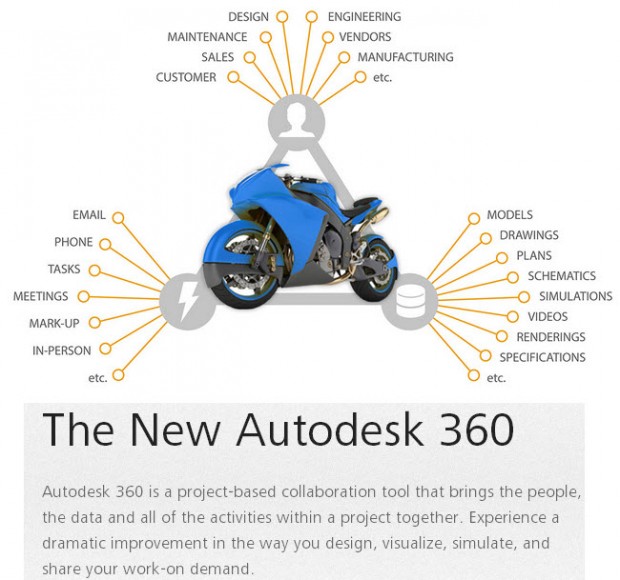 Did you know that the very same Cloud that was demonized by so many design firms resistant to any change, is the same platform that is making possible the cost effective, flexible management systems that the same SMB firms desperately need? Irony.
Did you know that the very same Cloud that was demonized by so many design firms resistant to any change, is the same platform that is making possible the cost effective, flexible management systems that the same SMB firms desperately need? Irony.
* Software as a Service (Saas)
* Platform as a service (PaaS)
* Integration as a Service (IaaS)
The cloud solves many issues including infrastructure and platform at a substantially reduced price. All you really need to do is access the software and make it work for you.
What Software?
There are a few companies that are working hard to fill the void.
These include Autodesk PLM 360, Microsoft Office 365 and Sharepoint, Arena PLM, Aras PLM, Ally PLM, Kenesto, Siemens Solid Edge SP, CADAC Organice, Autodesk 360, GrabCAD, and more.
Almost all of these have one factor in common. They were built for companies in the SMB space to fit a wide array of workflows and needs. All have very interesting strong points, but none fit the small, but broad range of needs. Today I want to review what Autodesk has been doing.
The Fusion Platform
I’d like to mention Autodesk’s Fusion /Sim/CAM 360. The entire data framework was built on PLM 360 platform, enabling a single, true source for all software to interact with. Managed data would no longer require aggregation from multiple design sources. They truly have a really good overall plan to integrate all these collaborative data management needs in a lightweight framework. The raw data is not accessible enough, nor are there instrumental workflow features yet, but I love the concept and wanted to give them an honorable mention here.
Jitterbit
Jitterbit (not affiliated with Autodesk) has a wonderful service that connects you’re a-la-carte datasets in a fluid manner, but at a substantial premium. Each paid connection increases the price and brings us right back to data management costing way too much for small companies. I mentioned them here because they have a great partnership with Autodesk for connecting Vault and PLM 360.
Autodesk PLM 360
Autodesk went after the overall need to manage data, developing a reasonably customizable framework and really did provide a good value and easy-to-adapt data management tool. The problem was that while they included some great design workflows and controls, there are some basic refinements that need to be fulfilled, and Autodesk completely left out the design data part. There is just no realistic method to store and catalogue CAD data on their cloud.
This is understandable as Autodesk already offers CAD PDM, Autodesk Vault, to their customers. Remember SMB data management is now a-la-carte. Jitterbit will gladly connect these two, but at an annual cost, and without any collaborative features. Viewing this from the perspective of a company who has purchased Vault Professional, it does seem weird that Autodesk expects customers used to transferring complex data between their CAD applications for free, to pay a significant annual fee to transfer metadata between their PDM and PLM products.
Autodesk 360 is getting an Overhaul
This product many of you know has been developed as a collaborative storage space. CAD
data is easily accessed by Autodesk CAD software, and people can be invited into the space to collaborate and discuss the design. There are numerous problems from a productive design platform perspective, including the fact that the files are not well discoverable, nor is there any method to catalogue data, and no real management. It’s simply storage and collaboration, and it’s not really comfortable to work in.
I sat in on a meeting with Sheila Wakida, Autodesk’s Sr. product manager for the cloud, who discussed the changes that are taking place in the Autodesk 360 platform. She discussed the timeline for the year and what the company was doing with Autodesk 360.
Better model viewing capabilities, CAD agnostic assembly and dependency detection, and integration with software and services to include things like Dropbox and Autodesk PLM 360.
That’s right. Shortly after Autodesk 360 becomes a premium service this summer, they will integrate PLM 360 in order to merge their capabilities (at this stage the service will only be available in the U.S., U.K., and Germany). That changes the scope of things substantially. Where companies would shun each product because it lacked the other’s capabilities, tying them together opens up a new realm of possibilities for some.
Add in very deep search algorithms, new dashboards for situation awareness and many more features, and Autodesk suddenly becomes much better suited to provide a useful data management solution that is accessible to small design firms.
… and the Battle Begins
Autodesk is not the only game in town. Vendors are diligently pulling together their ideas and solutions in an attempt to answer the question, “Who is providing USEFUL design management tools that meet the flexible needs of today’s small design companies?”. Come see what we found.
Image Credit: Mike King – Flickr & Autodesk
[subscribe2]






